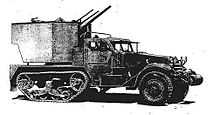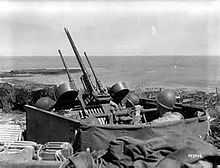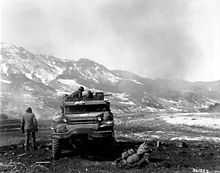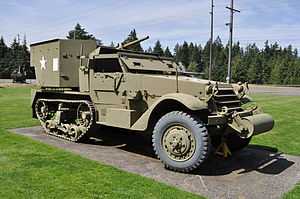M15 Halftrack
| M15 Combination Gun Motor Carriage | |
|---|---|
|
An M15A1 CGMC displayed at the Fort Lewis Military Museum | |
| Type | Self-propelled anti-aircraft gun |
| Place of origin | United States |
| Service history | |
| In service | 1943–53 |
| Wars |
World War II Korean War |
| Production history | |
| Designer | United States Army |
| Designed | 1940–42 |
| Manufacturer | White Motor Company, Autocar Company |
| Produced | 1942–44 |
| Number built | ~2,400 |
| Specifications | |
| Weight | 9.45 t (20,800 lb) |
| Length | 20 ft 3 in (6.17 m) |
| Width | 7 ft 4 in (2.24 m) |
| Height | 7 ft 10 in (2.39 m) |
| Crew | 7 |
|
| |
| Armor | 0–12 mm |
Main armament | 37 mm (1.5 in) Gun M1 with 2 × .50 cal M2 Browning machine guns |
| Engine |
White 160AX, 386 in3 (6,330 cc) 6-cylinder, petrol, compression ratio 6.3:1 128 hp (95 kW) |
| Power/weight | 15.8 hp/ton |
| Suspension | Half track, vertical volute springs; front leaf spring |
| Fuel capacity | 60 US gal (230 l) |
Operational range | 150 mi (240 km) |
| Speed | 41.9 mph (67.4 km/h) |
The M15 Halftrack, officially designated M15 Combination Gun Motor Carriage, was a self-propelled anti-aircraft gun on a half-track chassis used by the United States Army during World War II. It was equipped with one automatic 37 millimeter (1.5 in) gun and two water-cooled 0.5 in (12.7 mm) M2 Browning heavy machine guns in a coaxial mount controlled by an M6 sighting system. It was produced by the White Motor Company and Autocar between July 1942 and February 1944, and served alongside the M16 Multiple Gun Motor Carriage.
It evolved from the T28 project, initially as the T28E1 Combination Gun Motor Carriage (CGMC). It was accepted into service in 1943 as the M15, equipping US Army armored units during the latter stages of World War II. The 37 mm gun was often used as an infantry support weapon. The M15A1 was an improved variant with air-cooled machine guns mounted below the 37 mm gun. The M15 "Special" was based on the M15 but produced to fulfill the same role by mounting a Bofors 40 mm gun.
During World War II, the vehicle served the U.S. Army throughout the Mediterranean, European, and Pacific Theaters of Operations. During the Korean War, the M15 served alongside the M16 providing support to the infantry.
Specifications
The M15 was based on the M3 Halftrack chassis – a vehicle built from commercial components to maximize production. The M15 was 20 ft 3 in (6.17 m) long, 7 ft 4 in (2.24 m) wide, and 7 ft 10 in (2.39 m) high, with a wheelbase of 135.5 in (3.44 m).[1][2] The suspension for the wheels was leaf spring and the track bogies had vertical volute springs. The M15 had a fuel capacity of 60 US gal (230 l), which gave it a range of 150 miles (240 km). It was powered by a 386 in3 White 160AX, 128 hp[3][4] 6-cylinder petrol engine with a compression ratio of 6.44:1.[5] This produced a maximum road speed of 41.9 miles per hour (67.4 km/h). It had a power-to-weight ratio of 15.8 hp per ton.[1] Armament consisted of a fully automatic 37 mm (1.5 in) Gun M1 and two 0.50 cal (12.7 mm) M2 Browning machine guns mounted above the 37 mm gun.[1] With up to 12 mm of armor it weighed 9.45 t (20,800 lb) and had a crew of 7.[2]
Development

The M15 design developed from the T1A2 Multiple Gun Motor Carriage (MGMC) project, which was based on the M2 Half Track Car. With the addition of a 37 mm gun, this design became the T28. The T28 project was canceled in 1942 by the United States Army Coast Artillery Corps.[6][7]
T28E1
A United States Army Armored Force requirement for a mobile anti-aircraft gun to support the coming North African campaign resulted in the T28 project being revived soon after its cancellation. The new vehicles used an M3 Halftrack chassis, and were designated as the T28E1 CGMC.[8][9]
A total of 80 T28E1s were produced from July to August 1942, all of which had an unprotected mount for the gun combination and crew. Spotting targets was done with an M2E1 sighting system.[10] After 80 T28E1s had been produced, the vehicle went into production with the designation M15 CGMC.[6][11] Some of the T28E1s still in service were converted back into M3A1 Halftracks.[12]
M15, M15A1, M15 "Special"

The M15 was equipped with the M42 armored weapon mount, in which two water-cooled M2 Browning machine guns[3] were mounted above the 37 mm gun. A total of 680 M15s were produced in 1943 but because the M42 mount placed considerable stress on the M3 chassis, the M54 mount was introduced, and the resulting combination with the M3A1 Halftrack chassis was designated as the M15A1 CGMC.[8] In August 1945, the M42 mount, and the M15 CGMC was finally classified as obsolete.[10] The M54 gun mount reversed the places of the machine guns and 37 mm gun, and air-cooled M2 Browning machine guns replaced the water-cooled weapons used on the M15. An M6 sighting system was used for spotting targets.[10][13] A total of 1,052 M15A1s were produced in 1943, with a further 600 being produced in 1944. The unofficial name "M15 Special" relates to M15s and probably other CGMCs converted in depots in Australia to mount the Swedish-designed Bofors 40 mm gun on a halftrack chassis. This was the only successful conversion of a US halftrack to mount the Bofors gun.[14][15]
Service history
The proficiency of this mobile weapon can be attributed to three characteristics: its mobility, enabling to work well in close support of combat troops in forward areas and to patrol roads over which heavy traffic must travel under constant threat of bombing and strafing; its flexible firepower, combining the volume of caliber .50 with the knocking power of the 37 mm; and the facility which the fire is controlled, by using the tracer stream from the caliber .50 to bring it on target before opening up with the full volume of armament. Numerous cases are cited in which a "mouse trap" effect has been obtained which enemy planes came in much closer on the initial caliber .50 fire than they would on a light cannon and were caught by the 37 mm.[6]
The M15 was first used during Operation Torch, the Allied invasion of North Africa in November 1942. When engaging enemy aircraft, tracer ammunition from the machine guns was used to bring the main gun onto the target. T28E1 crews claimed more than 100 aircraft shot down during Operation Torch, the Battle of Kasserine Pass, and the Allied Invasion of Sicily; 39 alone were claimed at Kasserine.[16] One T28E1 was captured by the Germans at Kasserine Pass and was later rebuilt as a carrier for equipment and troops to replace German vehicles destroyed by Allied aircraft.[14][17]

Each US Army armored division was allocated an anti-aircraft artillery (AAA) company equipped with eight M15 CGMCs and eight M16 MGMCs (four Browning M2 machine guns). At corps and army level, each AAA battalion was equipped with 32 of each vehicle. After first seeing action in the Allied invasion of Italy, the M15 and M15A1 served through the rest of the Italian Campaign, the Allied invasion of Normandy, Operation Dragoon in southern France, and throughout the fighting on the Western Front, including the Battle of the Bulge. They were often used in the ground support role, as Allied air superiority meant that there were few German aircraft left to engage. They were also used in the Pacific theater during the campaign to liberate the Philippines and the Battle of Okinawa. The "M15 Special" was used by the 209th AAA Battalion in the Philippines in 1944–45. Several M15 "Special"s managed to avoid the post-war scrap down and were used in the Korean War.[17] The M15 and M15A1 also served in the ground-support role during the Korean War.[6][11][15][18] In one instance in the Korean War, an alert rifleman saved an M15 from several North Korean troops dressed in black, by bayonneting them in the chest.[19] A hundred M15s were shipped to the Soviet Union for use under the Lend-Lease. After the Korean War, many M15s were provided to Japan under the MAP program.[17]
See also
- M45 Quadmount
- List of U.S. military vehicles by model number
- List of U.S. military vehicles by supply catalog designation
- Sd.Kfz. 251, equivalent German halftrack
References
Citations
- ↑ 1.0 1.1 1.2 Berndt (1993), p. 152.
- ↑ 2.0 2.1 Ness (2002), p. 206.
- ↑ 3.0 3.1 Berndt (1994), p. 34.
- ↑ Hogg (1980)
- ↑ Hunnicutt (2001), p. 221.
- ↑ 6.0 6.1 6.2 6.3 6.4 Green (2000), p. 151.
- ↑ Gander (2013), p. 234.
- ↑ 8.0 8.1 Green (2000), p. 152.
- ↑ Zaloga (1994), p. 38.
- ↑ 10.0 10.1 10.2 Hunnicutt (2010), p. 131.
- ↑ 11.0 11.1 Berndt (1994) p. 32.
- ↑ Rottman (2012), p. 30.
- ↑ Hunter (1951), p. 220
- ↑ 14.0 14.1 Berndt (1994), p. 33.
- ↑ 15.0 15.1 Ness (2002) p. 153.
- ↑ Zaloga (1994), p. 38.
- ↑ 17.0 17.1 17.2 Zaloga (1994), pp. 42–43.
- ↑ Zaloga (1994), pp. 40–41.
- ↑ U.S. Army (1952), p. 28.
Bibliography
- Berndt, Thomas (1993). Standard Catalog of U.S. Military Vehicles. Iola, WI: Krause Publications. ISBN 0-87341-223-0.
- Berndt, Thomas (1994). American Tanks of World War II. Minneapolis, MN: MBI Publishing Company. ISBN 0-87938-930-3.
- Gander, Terry (2013). The Bofors Gun. Barnsley, UK: Pen and Sword. ISBN 1-47383-680-8.
- Green, Michael; Green, Gladys (2000). Weapons of Patton's Armies. Minneapolis, MN: MBI Publishing Company. ISBN 0-76030-821-7.
- Hogg, Ian V.; Weeks, John S. (1980). The Illustrated Encyclopedia of Military Vehicles. Englewood Cliffs, NJ: Prentice-Hall. ISBN 0-13450-817-3.
- Hunnicutt, R.P. (2010). Half-Track: A History of American Semi-Tracked Vehicles. Novato, CA: Presidio Press. ISBN 0-89141-742-7.
- Hunter, Kenneth E. (1951). The War Against Germany and Italy: Mediterranean And Adjacent Areas. United States Army in World War II. Washington, DC: Government Printing Office. ISBN 0-16087-289-8.
- Ness, Leland S. (2002). Jane's World War II Tanks and Fighting Vehicles. London, UK: HarperCollins. ISBN 0-00711-228-9.
- Rottman, Gordon (2009). World War II US Armored Infantry Tactics. Oxford, UK: Osprey Publishing. ISBN 1-78096-083-2.
- U.S. Army (1952). United States Army Combat Forces Journal, Volume 3. U.S. Army.
- Zaloga, Steven J. (1994). M3 Infantry Half-Track 1940–1973. New Vanguard. Oxford, UK: Osprey Publishing. ISBN 1-85532-467-9.
External links
| Wikimedia Commons has media related to Multiple Gun Motor Carriage M15. |
